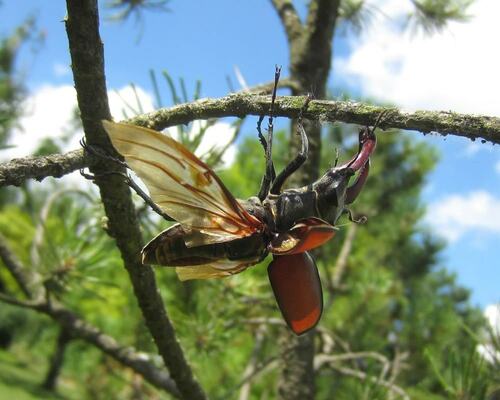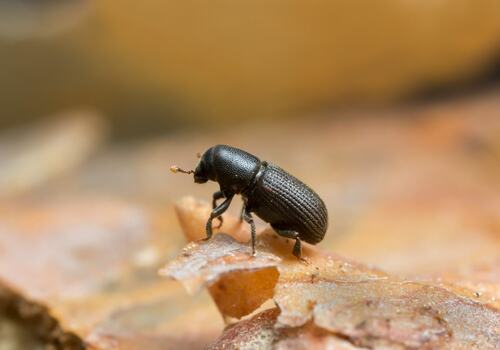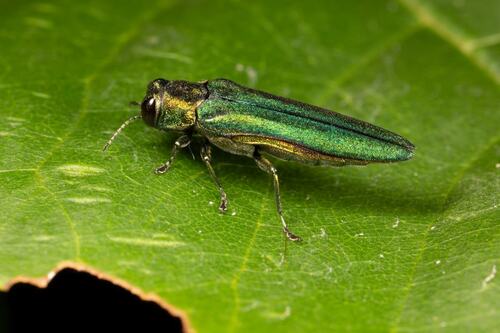Pest of the Month: Beetles

Introduction
This month we are going to cover a very common and destructive pest—the beetle.
There are many different species of beetles that can cause serious damage and issues in your trees, and they exist in large numbers and in most areas of the country. We are going to discuss which beetles are causing the problems and how you can avoid them in your own trees.
What is the Pest and How is it Causing Damage?

Photo by Pixabay
So, what is a beetle?
These insects are incredibly common, and they live in all kinds of different climates and areas. Because of this, they can often be mistaken for other bugs as well.
To determine whether or not you are looking at a beetle, first look for the wings and wing covers. Typically, most insects have wings, usually two pairs. For beetles, though, their first pair of wings is thickened and hardened to act as a protective shield for their delicate flying wings (which are underneath).
Their wing covers meet in a straight line down their back, and they are a “crunchier” bug. This means that if you do accidentally step on one, you will hear it.
How Beetles Cause Damage

A Bark Beetle Perched on a Piece of Wood
Borers
Beetles may try and bore into your tree bark, limbs, or even into their root system, which can cause serious harm. Depending on the type you are dealing with, some will attack fruit-bearing trees, ornamental trees, or even woody plants. Some also deposit their eggs under the bark or root systems of your tree, and as they hatch, they will feed on the plant life around them.
Some of these pests are tree-boring beetles, meaning that they go for weaker and more unhealthy trees that are under significant stress. Some of these include bark beetles, weevils, flatheaded metallic wood borers , and roundheaded longhorned borers. You will need to watch older, weaker trees for these as well as new trees that are planted near infected trees. The amount of damage in question will really depend on the specific tree’s health and the type of beetle.
On top of all the species that bore directly into the trees, some beetles attack trees from the ground and their roots. Most commonly, these are the California prionus beetle and the ten-lined June beetle (Polyphylla decemlineata). The larvae of these pests actually feed on the roots of different trees including cottonwood, poplar, black walnut, and cherry trees—this inevitably causes their death. Commonly, this type of beetle is known as a turf pest instead of a tree pest.
The amount of damage that you will see will vary greatly between the different types of beetles and trees in question. With weevils, the damage ranges from leaf discoloration and holes all the way to sap stains and bark loss, which kills the trees. With bark beetles, they tunnel beneath the bark, leading to bark loss and tree death.
Defoliators
Beetles that defoliate plants, such as the Japanese beetle and the elm leaf beetle, pose significant threats to various plant species. The Japanese beetle (Popillia japonica), an invasive species in North America, is notorious for its broad diet, feeding on over three hundred plant species' foliage, flowers, and fruits. Adult beetles skeletonize leaves, leaving only veins, while their larvae feed on grass roots, damaging lawns and turf. This widespread destruction makes Japanese beetles a major concern for gardeners, farmers, and arborists.
Similarly, the elm leaf beetle (Xanthogaleruca luteola) is a significant pest for elm trees. Native to Europe, this beetle has spread to many parts of the world, including North America. Elm leaf beetles damage elm trees by feeding on their leaves, leading to defoliation. Larvae feed on the underside of leaves, creating a skeletonized appearance, while adults chew through entire leaves. Severe infestations can lead to complete defoliation, stressing trees and making them more susceptible to diseases and other pests. Control measures often include chemical treatments, biological controls, and cultural practices to manage their impact on plant health.
The Best Pest Control for Beetles

An Emerald Ash Borer on a Leaf
What can you do to prevent beetle damage on your trees?
The best preventative measure you can take to get rid of beetles is to keep the trees in your care extremely healthy and strong. Make sure to prune regularly, get rid of any weak and/or infested limbs, and be aware of the state of your trees throughout the year. If you are removing any limbs, burn them to kill any remaining pests.
Another way to prevent this issue is to keep the areas around the trees clean-cut and free of weeds and any other debris. This assists in keeping the beetles away from the trunks and roots of your trees.
Larvae often does a lot of damage to tree roots and the ground surrounding the tree, so insecticides like pyrethroids can eliminate the beetles before the females lay their eggs and cause any issues.
Our Final Thoughts on Beetles
Effective beetle management is crucial to maintaining healthy trees and landscapes. Regular monitoring, combined with preventative measures such as pruning, chemical treatments, and maintaining tree vigor, can significantly reduce beetle infestations. By staying proactive and informed about potential threats, you can help ensure your trees remain robust and beautiful throughout the year. For more tailored advice or assistance, don't hesitate to reach out to our team at Arborist Now.
Originally published on October 26, 2018.





